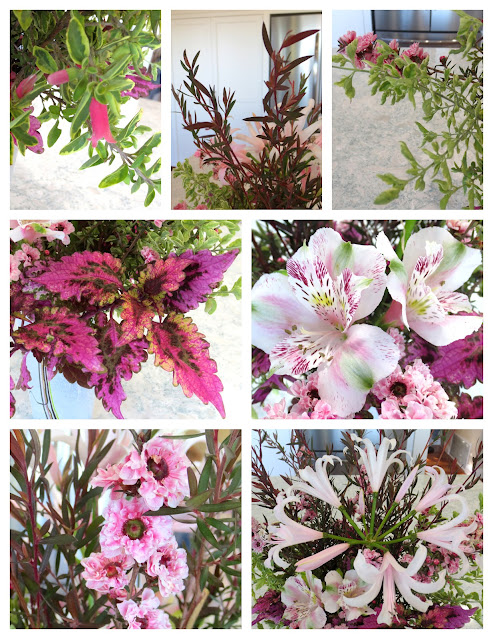Seedlings and new bulb foliage are just beginning to emerge in my cutting garden.
 |
| Tiny larkspur (Consolida ajacis) and more robust sweet pea (Lathyrus annuus) seedlings have made an appearance, along with the first of the love-in-a-mist (Nigella papillosa) seedlings (not shown). The Anemone coronaria bulbs are also beginning to produce foliage. |
Unfortunately, the opossums have also been having a field day with the cutting garden.
 |
| I covered most but not all of the surface of the cut garden beds, leaving open spaces around some of the edges and the foxglove plugs. The opposums took advantage of the smallest openings. I've since filled in the uncovered areas with more mesh and I've used a lot more lawn staples to keep the mesh more firmly in place. |
Fall is the best time to plant in my climate and I've been filling in empty spots elsewhere in the garden too.
 |
| With the dahlias removed from this barrel, I added Alternanthera 'Choco Chili', Argyranthemum 'Grandaisy 'Dark Pink', Calibrachoa 'Supercal Cherry', and a noID Digitalis purpurea. I left the Dianthus planted there last year in place. |
 |
| I finally planted the 2 native Heuchera maxima I'd ordered earlier from Annie's Annuals and potted up, after cutting back the original Heuchera, These don't have the colorful foliage of the newer hybrid Heucheras but they're tough plants. Freesia foliage is already coming up here and elsewhere in the garden. |
 |
| I added a dozen plugs of the annual Pericallis hybrid commonly known as Cineraria to fill in the spaces between Euphorbia characias 'Black Pearl', the emerging Dutch Iris, and a few other plants. Formerly classified as a Senecio hybrid, Cineraria are a cross between Pericallis cruenta and P. lanata. I've always loved their colorful daisy flowers, which grow well in partial shade if protected from snails and leafminers. |
 |
| I decided to try more Arthropodium cirratum (aka Renga lilies) in this area under the ornamental pear tree. In my experience, these plants tolerate dry shade well. Rather than dividing some of my existing plants, I took the easy route and ordered 3 from Annie's Annuals & Perennials. Before planting, I also supplemented the soil with homemade compost. Self-sown seedlings of Polygala myrtifolia are filling in the empty spaces between them. |
 |
| Clockwise from the upper left, I also planted Achillea millefolium 'Sonoma White' (3), Muhlenbergia capillaris (1), Osteospermum hybrid '4D Sunburst' (3), and Rubus calycinoides (4). All but the Osteospermum came from Annie's. Rubus is an interesting groundcover said to grow 4 inches high and 4 feet wide. |
 |
| I'm always adding new succulents too, including 2 Aeonium escobarii and another well-priced Mangave 'Aztec King'. The Aeonium develops a well-formed clump, which you can see here. The Mangave replaces a Kalanchoe that wasn't happy in one succulent bed in my back garden. |
 |
| I potted up all the new Hippeastrum bulbs I purchased by mail order too. On the left are 'Aphrodite', 'Exception', 'Elvas', and 'Zombie'. On the upper right are 'Lemon Star', 'Emerald', and 'Evergreen' and on the lower right is 'Apricot Parfait', already out the gate. |
I've continued to chip away at cleaning up the back slope too. Working in the garden has been a distraction from worrying about my cat, Pipig. We've paid two visits to the vet this month. During the second, the vet took an x-ray and concluded that her current hacking cough could be attributable to either a reemergence of the cancer she was treated for in 2019 or pneumonia. The vet's sent her record to a veterinary cancer specialist and, in the meantime, we're trying antibiotics.
 |
| She's 17 years old now but I'm having a hard time facing the prospect of her loss. In any case, I want to ensure she's as comfortable as possible during whatever time she has left. |
 |
| She read the signals of an impending trip to the vet (which is now a 40-minute drive in each direction) and she took refuge on the top shelf of her catio. My husband's assistance was required to get her down. She wasn't at all pleased. |
I haven't slept well in over a week. Hopefully, we're dealing with bacterial pneumonia and the antibiotic will do the trick. Pipig, my patient husband, and I could use some rest over the long holiday weekend.
All material © 2012-2023 by Kris Peterson for Late to the Garden Party
























































